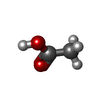[English] 日本語
 Yorodumi
Yorodumi- PDB-1n2r: A natural selected dimorphism in HLA B*44 alters self, peptide re... -
+ Open data
Open data
- Basic information
Basic information
| Entry | Database: PDB / ID: 1n2r | ||||||
|---|---|---|---|---|---|---|---|
| Title | A natural selected dimorphism in HLA B*44 alters self, peptide reportoire and T cell recognition. | ||||||
 Components Components |
| ||||||
 Keywords Keywords | IMMUNE SYSTEM / MHC I | ||||||
| Function / homology |  Function and homology information Function and homology informationantigen processing and presentation of peptide or polysaccharide antigen via MHC class II / regulation of interleukin-12 production / regulation of dendritic cell differentiation / regulation of T cell anergy / regulation of interleukin-6 production / TAP binding / protection from natural killer cell mediated cytotoxicity / antigen processing and presentation of endogenous peptide antigen via MHC class Ib / antigen processing and presentation of endogenous peptide antigen via MHC class I via ER pathway, TAP-independent / detection of bacterium ...antigen processing and presentation of peptide or polysaccharide antigen via MHC class II / regulation of interleukin-12 production / regulation of dendritic cell differentiation / regulation of T cell anergy / regulation of interleukin-6 production / TAP binding / protection from natural killer cell mediated cytotoxicity / antigen processing and presentation of endogenous peptide antigen via MHC class Ib / antigen processing and presentation of endogenous peptide antigen via MHC class I via ER pathway, TAP-independent / detection of bacterium / negative regulation of receptor binding / secretory granule membrane / early endosome lumen / Nef mediated downregulation of MHC class I complex cell surface expression / DAP12 interactions / transferrin transport / cellular response to iron ion / Endosomal/Vacuolar pathway / Antigen Presentation: Folding, assembly and peptide loading of class I MHC / peptide antigen assembly with MHC class II protein complex / lumenal side of endoplasmic reticulum membrane / cellular response to iron(III) ion / MHC class II protein complex / negative regulation of forebrain neuron differentiation / antigen processing and presentation of exogenous protein antigen via MHC class Ib, TAP-dependent / ER to Golgi transport vesicle membrane / peptide antigen assembly with MHC class I protein complex / regulation of iron ion transport / regulation of erythrocyte differentiation / HFE-transferrin receptor complex / defense response / response to molecule of bacterial origin / MHC class I peptide loading complex / T cell mediated cytotoxicity / positive regulation of T cell cytokine production / antigen processing and presentation of endogenous peptide antigen via MHC class I / antigen processing and presentation of exogenous peptide antigen via MHC class II / positive regulation of immune response / MHC class I protein complex / positive regulation of T cell activation / peptide antigen binding / positive regulation of receptor-mediated endocytosis / negative regulation of neurogenesis / cellular response to nicotine / positive regulation of T cell mediated cytotoxicity / multicellular organismal-level iron ion homeostasis / specific granule lumen / phagocytic vesicle membrane / recycling endosome membrane / Interferon gamma signaling / Immunoregulatory interactions between a Lymphoid and a non-Lymphoid cell / negative regulation of epithelial cell proliferation / MHC class II protein complex binding / Interferon alpha/beta signaling / Modulation by Mtb of host immune system / late endosome membrane / sensory perception of smell / positive regulation of cellular senescence / tertiary granule lumen / DAP12 signaling / T cell differentiation in thymus / negative regulation of neuron projection development / protein-folding chaperone binding / ER-Phagosome pathway / protein refolding / early endosome membrane / protein homotetramerization / amyloid fibril formation / adaptive immune response / intracellular iron ion homeostasis / learning or memory / endosome membrane / immune response / endoplasmic reticulum lumen / Amyloid fiber formation / signaling receptor binding / Golgi membrane / innate immune response / lysosomal membrane / external side of plasma membrane / focal adhesion / Neutrophil degranulation / SARS-CoV-2 activates/modulates innate and adaptive immune responses / structural molecule activity / cell surface / endoplasmic reticulum / Golgi apparatus / protein homodimerization activity / extracellular space / extracellular exosome / extracellular region / identical protein binding / membrane / plasma membrane / cytosol Similarity search - Function | ||||||
| Biological species |  Homo sapiens (human) Homo sapiens (human) | ||||||
| Method |  X-RAY DIFFRACTION / X-RAY DIFFRACTION /  SYNCHROTRON / SYNCHROTRON /  MOLECULAR REPLACEMENT / Resolution: 1.7 Å MOLECULAR REPLACEMENT / Resolution: 1.7 Å | ||||||
 Authors Authors | Macdonald, W.A. / Purcell, A.W. / Williams, D.S. / Mifsud, N. / Ely, L.K. / Gorman, J.J. / Clements, C.S. / Kjer-Nielsen, L. / Koelle, D.M. / Brooks, A.G. ...Macdonald, W.A. / Purcell, A.W. / Williams, D.S. / Mifsud, N. / Ely, L.K. / Gorman, J.J. / Clements, C.S. / Kjer-Nielsen, L. / Koelle, D.M. / Brooks, A.G. / Lovrecz, G.O. / Lu, L. / Rossjohn, J. / McCluskey, J. | ||||||
 Citation Citation |  Journal: J.Exp.Med. / Year: 2003 Journal: J.Exp.Med. / Year: 2003Title: A naturally selected dimorphism within the HLA-B44 supertype alters class I structure, peptide repertoire, and T cell recognition. Authors: Macdonald, W.A. / Purcell, A.W. / Mifsud, N.A. / Ely, L.K. / Williams, D.S. / Chang, L. / Gorman, J.J. / Clements, C.S. / Kjer-Nielsen, L. / Koelle, D.M. / Burrows, S.R. / Tait, B.D. / ...Authors: Macdonald, W.A. / Purcell, A.W. / Mifsud, N.A. / Ely, L.K. / Williams, D.S. / Chang, L. / Gorman, J.J. / Clements, C.S. / Kjer-Nielsen, L. / Koelle, D.M. / Burrows, S.R. / Tait, B.D. / Holdsworth, R. / Brooks, A.G. / Lovrecz, G.O. / Lu, L. / Rossjohn, J. / McCluskey, J. | ||||||
| History |
|
- Structure visualization
Structure visualization
| Structure viewer | Molecule:  Molmil Molmil Jmol/JSmol Jmol/JSmol |
|---|
- Downloads & links
Downloads & links
- Download
Download
| PDBx/mmCIF format |  1n2r.cif.gz 1n2r.cif.gz | 102.6 KB | Display |  PDBx/mmCIF format PDBx/mmCIF format |
|---|---|---|---|---|
| PDB format |  pdb1n2r.ent.gz pdb1n2r.ent.gz | 77.6 KB | Display |  PDB format PDB format |
| PDBx/mmJSON format |  1n2r.json.gz 1n2r.json.gz | Tree view |  PDBx/mmJSON format PDBx/mmJSON format | |
| Others |  Other downloads Other downloads |
-Validation report
| Summary document |  1n2r_validation.pdf.gz 1n2r_validation.pdf.gz | 390.5 KB | Display |  wwPDB validaton report wwPDB validaton report |
|---|---|---|---|---|
| Full document |  1n2r_full_validation.pdf.gz 1n2r_full_validation.pdf.gz | 394.3 KB | Display | |
| Data in XML |  1n2r_validation.xml.gz 1n2r_validation.xml.gz | 9.4 KB | Display | |
| Data in CIF |  1n2r_validation.cif.gz 1n2r_validation.cif.gz | 16.6 KB | Display | |
| Arichive directory |  https://data.pdbj.org/pub/pdb/validation_reports/n2/1n2r https://data.pdbj.org/pub/pdb/validation_reports/n2/1n2r ftp://data.pdbj.org/pub/pdb/validation_reports/n2/1n2r ftp://data.pdbj.org/pub/pdb/validation_reports/n2/1n2r | HTTPS FTP |
-Related structure data
- Links
Links
- Assembly
Assembly
| Deposited unit | 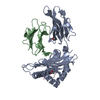
| ||||||||
|---|---|---|---|---|---|---|---|---|---|
| 1 |
| ||||||||
| Unit cell |
|
- Components
Components
| #1: Protein | Mass: 31978.328 Da / Num. of mol.: 1 Source method: isolated from a genetically manipulated source Details: Truncated B*4403 heavy chain / Source: (gene. exp.)  Homo sapiens (human) / Gene: HLA-B OR HLAB / Plasmid: pET / Species (production host): Escherichia coli / Production host: Homo sapiens (human) / Gene: HLA-B OR HLAB / Plasmid: pET / Species (production host): Escherichia coli / Production host:  | ||||
|---|---|---|---|---|---|
| #2: Protein | Mass: 11748.160 Da / Num. of mol.: 1 Source method: isolated from a genetically manipulated source Source: (gene. exp.)  Homo sapiens (human) / Gene: B2M / Plasmid: pET / Species (production host): Escherichia coli / Production host: Homo sapiens (human) / Gene: B2M / Plasmid: pET / Species (production host): Escherichia coli / Production host:  | ||||
| #3: Protein/peptide | Mass: 1090.165 Da / Num. of mol.: 1 / Source method: obtained synthetically Details: THE PROTEIN WAS CHEMICALLY SYNTHESIZED. THE SEQUENCE OF THE PROTEIN IS NATURALLY FOUND IN HOMO SAPIENS. It was Derived from the HLA DPalpha (DP A*0201) polypeptide chain. References: GenBank: 14602923, UniProt: Q95HB9*PLUS | ||||
| #4: Chemical | | #5: Water | ChemComp-HOH / | Has protein modification | Y | |
-Experimental details
-Experiment
| Experiment | Method:  X-RAY DIFFRACTION / Number of used crystals: 1 X-RAY DIFFRACTION / Number of used crystals: 1 |
|---|
- Sample preparation
Sample preparation
| Crystal | Density Matthews: 2.55 Å3/Da / Density % sol: 51.76 % |
|---|---|
| Crystal grow | Temperature: 298 K / Method: vapor diffusion, hanging drop / pH: 5.2 Details: 30% PEG 4K, 0.1M citrate, 0.2M ammonium acetate, pH 5.2, VAPOR DIFFUSION, HANGING DROP, temperature 298K |
-Data collection
| Diffraction | Mean temperature: 100 K |
|---|---|
| Diffraction source | Source:  SYNCHROTRON / Site: SYNCHROTRON / Site:  APS APS  / Beamline: 14-BM-C / Wavelength: 1 Å / Beamline: 14-BM-C / Wavelength: 1 Å |
| Detector | Type: ADSC QUANTUM 4 / Detector: CCD / Date: Apr 1, 2002 |
| Radiation | Protocol: SINGLE WAVELENGTH / Monochromatic (M) / Laue (L): M / Scattering type: x-ray |
| Radiation wavelength | Wavelength: 1 Å / Relative weight: 1 |
| Reflection | Resolution: 1.7→100 Å / Num. all: 50616 / Num. obs: 50616 / % possible obs: 96.7 % / Observed criterion σ(F): -3 / Observed criterion σ(I): -3 |
| Reflection shell | Resolution: 1.7→1.76 Å / % possible all: 93.5 |
- Processing
Processing
| Software |
| ||||||||||||
|---|---|---|---|---|---|---|---|---|---|---|---|---|---|
| Refinement | Method to determine structure:  MOLECULAR REPLACEMENT / Resolution: 1.7→50 Å / σ(F): 0 / MOLECULAR REPLACEMENT / Resolution: 1.7→50 Å / σ(F): 0 /
| ||||||||||||
| Refinement step | Cycle: LAST / Resolution: 1.7→50 Å
|
 Movie
Movie Controller
Controller


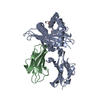
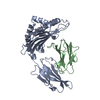
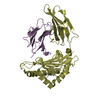
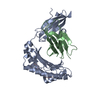

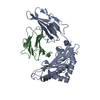
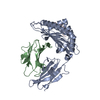
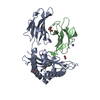
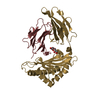
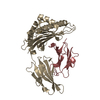
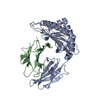
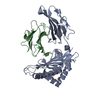

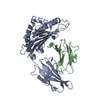
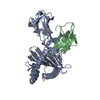
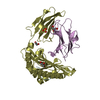
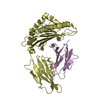

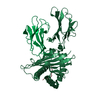
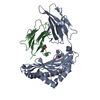
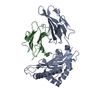
 PDBj
PDBj





